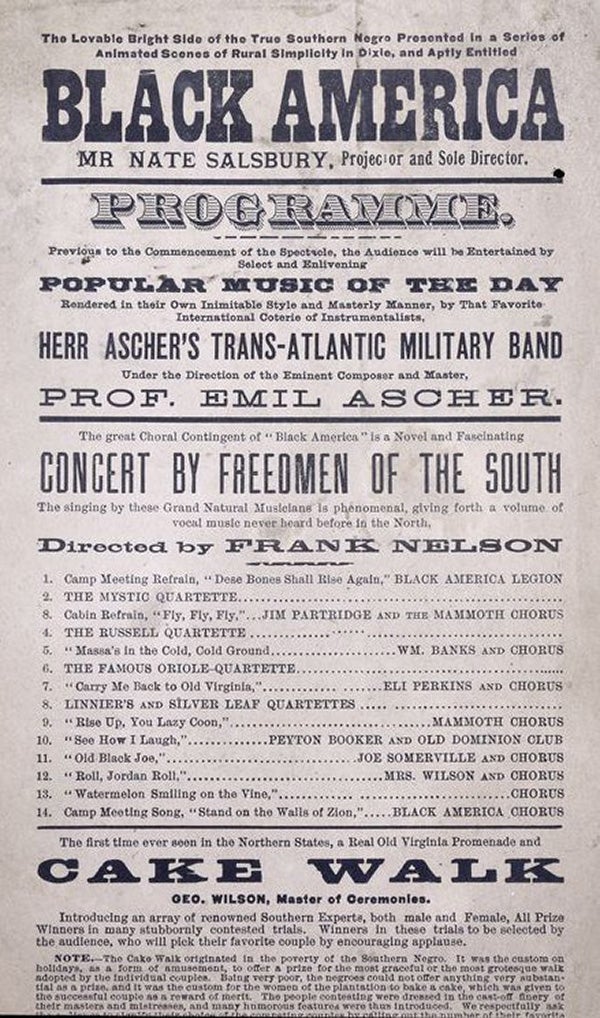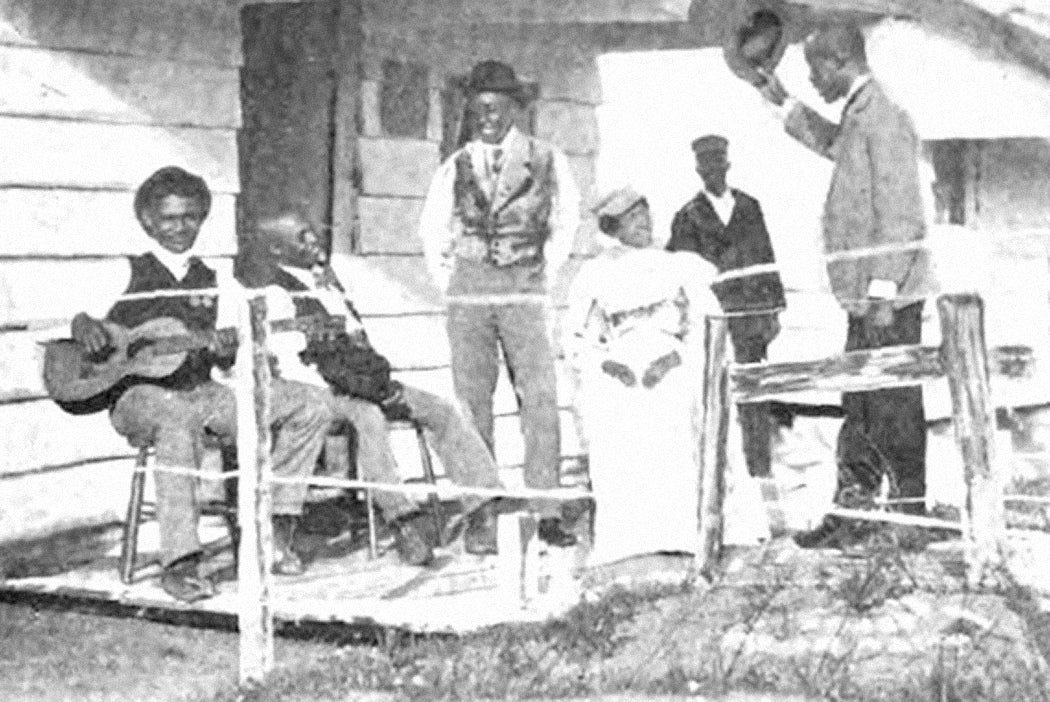From a modern perspective, the idea of “living history” has become not only common but popular, with influencers and fans eagerly engaging in historical costuming, re-enacting battles of the past, and chowing down on turkey legs at the local Renaissance Faire. The concept was relatively new in 1895, but that didn’t stop promoter Nate Salsbury from mounting a massive experiential production in Brooklyn on the Ambrose Park fairground. Entitled Black America, Salsbury’s show purported to show a genuine Southern Black community and demonstrate Black cultural progress in America, from enslavement to citizenship.
Black America opened on May 25, 1895, and played in New York, Boston, Washington, and Philadelphia before closing roughly six months later. Claiming to present as “the Negro as he really is…in the amusement world as an educator with natural surroundings,” the exposition presented a sprawling re-creation of plantation life and labor, concluding with an evening theatrical show. Arriving at the grounds, visitors stepped into a village of 150 log cabins with an acre of planted cotton in the near distance (Librarian Dorothy Berry notes that, for efficiency’s sake, the field was “ingeniously manufactured from real cotton plant stalks, with cotton fluff loosely attached by wire”). Military tents housed members of the all-Black United States Ninth Cavalry. Five hundred cast members, who were said to be regular people and most certainly not actors (ahem), played cards, worked, danced, and interacted with strolling patrons.
When evening fell, Black America offered an all-singing, all-dancing arena show for thousands of visitors. The stage elevated as many as four hundred singers, placing them amidst set dressing that showed a folksy steamboat wharf, mountains, hay bales, and barrels of sugar and molasses. Theater scholar Roger Allan Hall describes a show in three parts, all trading on stereotype and parallels to minstrel entertainment: first, a robust program of music and dancing, including “Watermelon Smiling on the Vine” and an accompanying pastiche.
“Even more popular,” Hall assures, “was the cakewalk.”
A second act presented military drills and conventional circus acts, including the contortionist Pablo Diaz, “billed as “the human corkscrew.” In the grand finale, entitled “Historical Apotheosis,” the full cast “appeared in various drills, and huge portraits of General Grant, Fred Douglass, Harriet Beecher Stowe, General Sherman, John Brown, and Abraham Lincoln were displayed as the chorus sang appropriate songs.”
Black America was a key development in American reality entertainment, insisting as it did that the whole affair was a true representation of Black life—docile, patriotic, economically supportive—rather than a contrived stage production. One cannot help but share the question raised by African studies professor Lori L. Brooks:
What was the public’s investment in identifying the African American performers in Black America as individuals devoid of the artifice that commercial entertainment entailed, in other words, to see them billed as “the real thing” rather than actors and artists performing for a paying audience? What satisfactions did such investments in black “naturalism” provide for its white audiences?
The show’s billing as a “Gigantic Exposition of Negro Life and Character” clearly linked it to a turn-of-the-century entertainment culture that explored the concept of “edutainment.” This was perhaps nowhere more evident than in the 1893 Columbian Exposition, which also dipped its toe into the Eurocentric idea of ethnographic amusement. But the lineage of Black America also looks to circus entertainment, which eagerly embraced whitewashed spectacle, and particularly to Wild West shows and their highly commercial embrace of dramatized history. Black America’s producer Salsbury was also the manager and producer of Buffalo Bill Cody’s famous Wild West spectacular, and largely borrowed the structure and function (and even the log cabins) from one production to create the other.

Brooks points out that, structurally, the point of Black America was similar to that of the Wild West show: the invisible, civilizing hand of white paternalism. By celebrating the allegedly “natural” Southern state and arts of Black Americans, the production hoped to rewrite popular memory wholesale. It was in many ways a nostalgic retcon with which white communities could reassure themselves that questions of racism and history had simple, comfortable answers. Many welcomed that assurance, since the Northern and national climate at the time was far from easy around questions of Black rights and citizenship. Black America appeared at a time of nativist anxiety over an increasingly stretched job market, of New York’s (dubiously effective) Civil Rights Act of 1895 and the (disappointingly effective) ruling in Plessy v. Ferguson.
That said, not everyone agrees that the show was reductive and limiting. In her studies of racial identity, Barbara L. Webb argues that Black America, particularly its stage show, offered performers a venue in which to negotiate a new, modern cultural identity that acknowledged but superseded the constraints of slavery and racist social systems. Even within a closely defined entertainment universe, Black performers celebrated in community their musical excellence, military service to America, and historically informed dance tradition (let’s not forget, writes Berry, that the cakewalk was “developed originally by enslaved people as a satirical masquerade mocking the stilted promenades of their upper-class enslavers”).
Weekly Newsletter
“The plantation themes and performance content of South Before the War and Black America,” Webb writes, “were not simply white-mandated masks worn by African American performers. Rather, they were also materials with which African American performers created contested possibilities for racially representative performance.”
Webb also points out that Salsbury may well have produced Black America, but that the show’s Black creative director, Billy McClain, “likely conceived and directed it.”
Unlike Cody’s Wild West shows, Black America never toured Europe, though Salsbury had intended it to do so. Whether due to management issues or poor attendance, the show closed after a short run and is remembered as a complicated artifact of early American reality entertainment.
Three Teaching Tips:
Consider evolving scholarship: How has the meaning of Black America changed since the 1966 publication of Gerlyn E. Austin’s analysis of Black American actors?
Contextualize Black America in the history of African American theater: Consider the extravagance of Ambrose Park (Brooklyn) shows against the more urban performances in turn-of-the-century New York City.
Support JSTOR Daily! Join our membership program on Patreon today.







